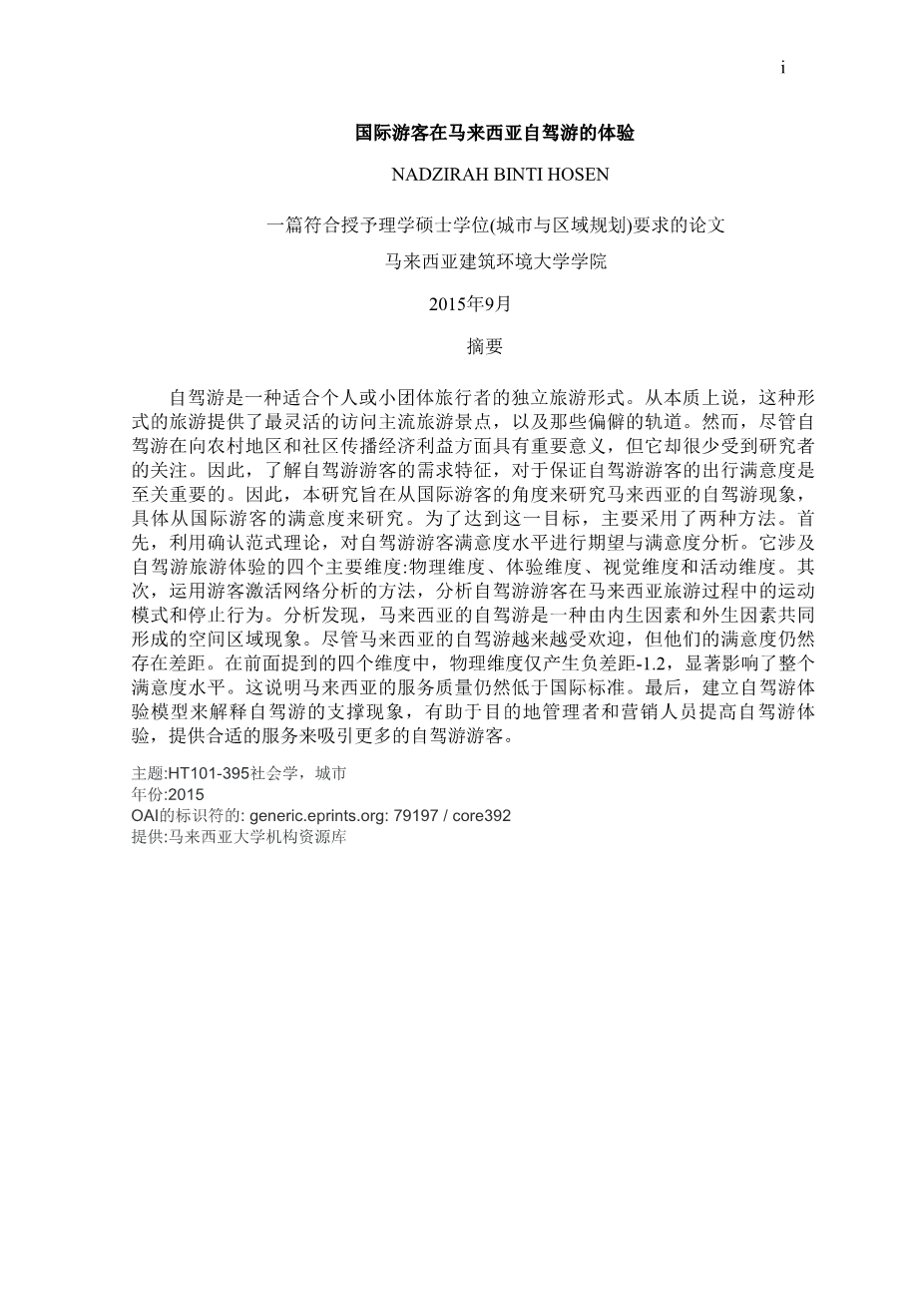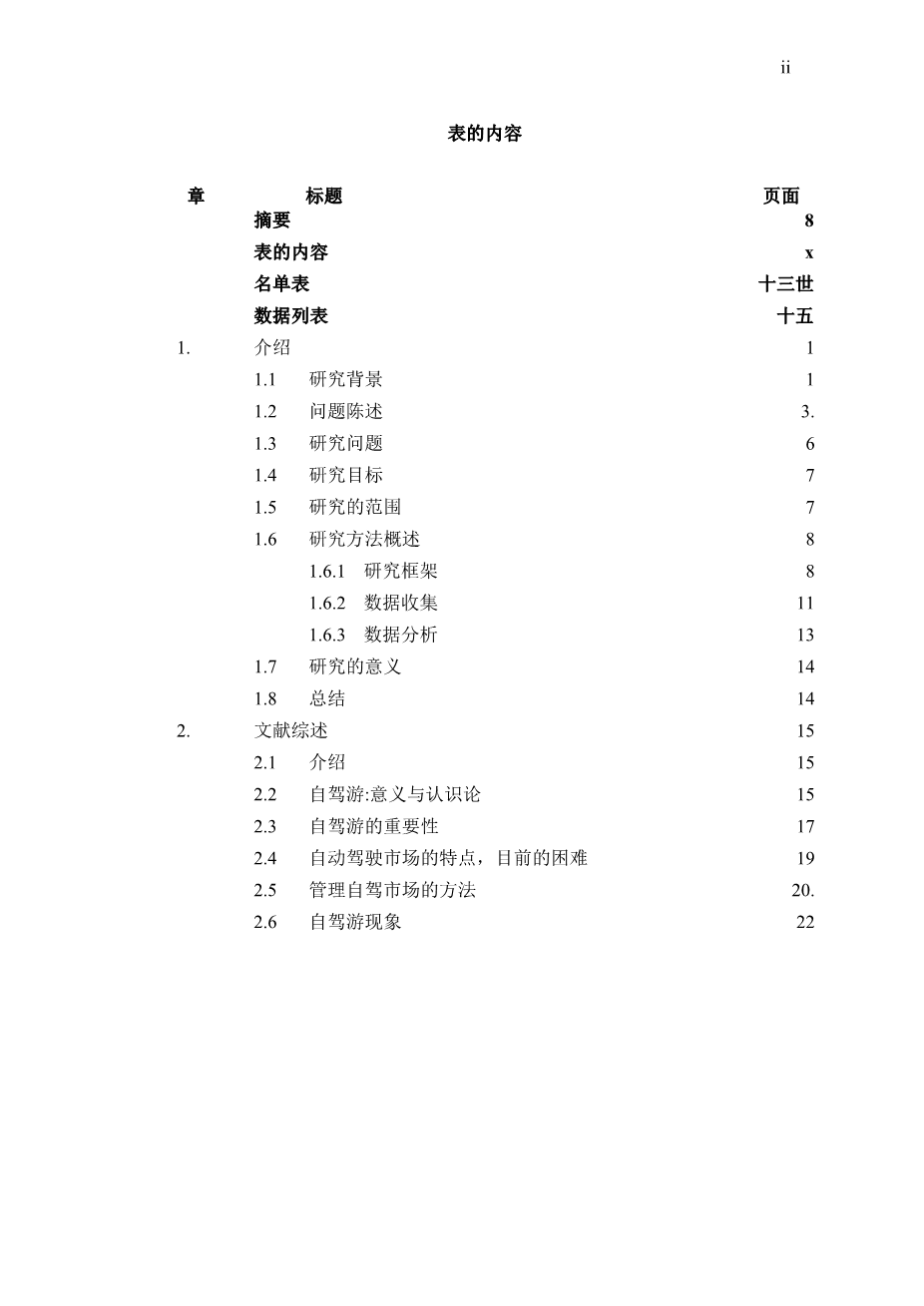THE EXPERIENCE OF SELF-DRIVE INTERNATIONAL TOURISTS IN MALAYSIA
NADZIRAH BINTI HOSEN
A thesis submitted in fulfilment of the requirements for the award of the degree of Master of Science (Urban and Regional Planning)
Faculty of Built Environment Universiti Teknologi Malaysia
SEPTEMBER 2015
ABSTRACT
Self-drive tourism is an independent form of travel which suits an individual or small group of travellers. In essence this form of tourism offers the most flexible visitation to mainstream tourist attractions as well as those off the beaten track. Nevertheless, self-drive tourism has received relatively little attention from researchers despite its significance in spreading economic benefits to rural areas and communities. In this light, understanding the demand characteristics of self-drive tourists is essential in ensuring their trip satisfaction. Hence, this study aims to investigate the phenomenon of self-drive tourism in Malaysia from the perspective of international tourists, specifically in terms of their satisfaction levels. To meet this objective two main methods are applied. Firstly, the Expectation and Satisfaction Analysis is used to measure the level of self-drive tourist satisfaction by using the Confirmation Paradigm Theory. It involves four main dimensions in the self-drive tourist experience namely; the physical dimension, experiential dimension, visual dimension and activity-based dimension. Secondly, the Tourist-Activated Network Analysis is used to understand the movement patterns and stopping behaviour of self-drive tourists during their trips in Malaysia. Based on the analysis, it was found out that self-drive tourism in Malaysia is spatially a regional phenomenon which is shaped by endogenous and exogenous factors. Despite the growing popularity of self-drive tourism in Malaysia, there are still gaps in their satisfaction levels. Among four dimensions stated previously, physical dimension has merely generated a negative gap of -1.2 which significantly affects the whole level of satisfaction. This has indicated that the service quality in Malaysia is still below the international standard. Finally, a model of self-drive tourism experience is developed to explain the underpinning phenomenon of self-drive tourism in this country which can help destination managers and marketers in enhancing the self-drive travel experience and provide appropriate services to attract more self-drive tourists to the country.
Topics: HT101-395 Sociology, Urban
Year: 2015
OAI identifier: oai:generic.eprints.org:79197/core392
Provided by: Universiti Teknologi Malaysia Institutional Repository
CHAPTER 1
1. INTRODUCTION
Background of the study
The booming in private automobile ownership since the post-second World War has transformed the landscape of tourism in many developed nations. North America, Australia and New Zealand have the highest car ownership levels with an average of over 500 cars per 1,000 persons, and followed by European cities, with over 414 cars per 1,000 persons (Kenworthy, 1993). As ownership and usage levels of cars are high and rise over time, the interest in self-drive tourism is expected will increase too.
It is believed that car has become the most preferred mode of transport for land travel due to its ability in facilitating dispersal more than other mode of transport (AMR Interactive, 2000; Derrett, 2002; Hardy, 2005; Prideaux amp; Carson, 2003). Thus it enables travellers to access places that are inaccessible by bus or rail, which seems to benefit the tourism industry enormously. This is very important for the development of outback destinations and rural areas which rely very much on the carlsquo;s ability to access remote areas. Consequently, it is apparent that the self-drive tourism plays a vital role in spreading economic benefits of tourism more than any other forms of travel. As car is also flexible and independent, travellers are not constrained from the fixed schedules and limited network options.
So far, the new travel behaviour of self-drive tourism has significantly grown worldwide and it can be seen through the changing trend or demand of the travellers. As noted by Schmallegger (2011), there has been a major change in the tourist travel
pattern that is from a conventional mass tourism into an individualistic form. In developed nations particularly, car has become the main form of holiday transport for domestic travellers. Previous studies by Carson amp; Waldhoer (2011), Hardy (2003), Lohmann et al. (2011), Timothy (2011) and Yu et al. (2011) show that over 70 to 80 per cent of total tourism trips made by domestic tourists globally are constituted by the self-drive tourists. These phenomena have significantly exposed the desire of tourists for a travel experience that is more independent and flexible. Moreover, the driving itself is often the central part of the travel experience in the term of ‗touring for pleasurelsquo; (Hardy amp; Gretzel, 2011).
While in Malaysia, serious priority has been given to the development of tourism since 1970s. The emphasis on tourism development started after the Tourist Development Corporation Malaysia (TDCM) was established in 1972 (Hamzah, 2004). Although Malaysia is a new entrant in the tourism industry as compared to other established ASEAN neighbours such as Singapore and Thailand, it has shown a positive and remarkable growth over the last periods. According to the United Nations World Tourism Organization (UNWTO), Malaysia ranked ninth of the most visited country in the world and 14lt;
剩余内容已隐藏,支付完成后下载完整资料


英语译文共 22 页,剩余内容已隐藏,支付完成后下载完整资料
资料编号:[605494],资料为PDF文档或Word文档,PDF文档可免费转换为Word


